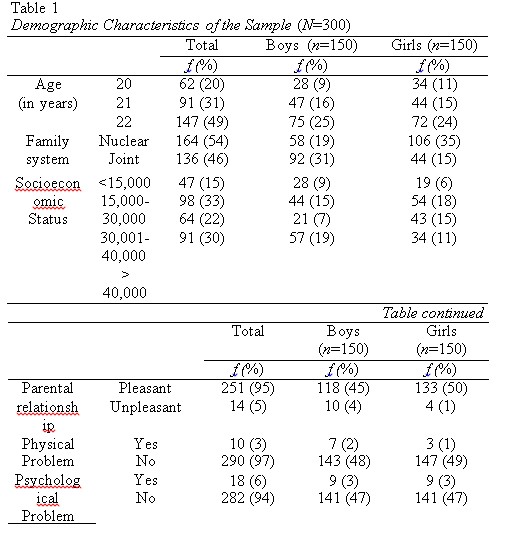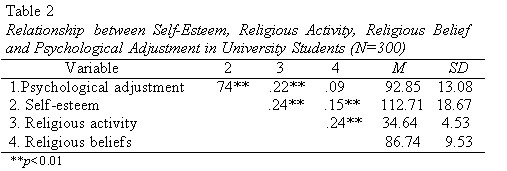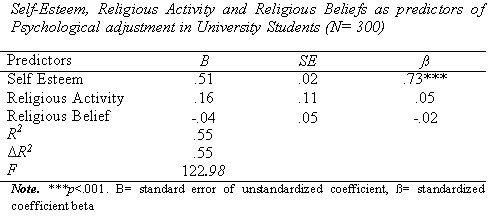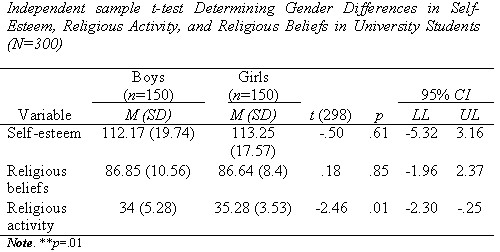SELF ESTEEM, RELIGIOSITY, AND PSYCHOLOGICAL ADJUSTMENT AMONG UNIVERSITY STUDENTS
Tehreem Arshad and Zunairah Uzair
Centre for Clinical Psychology, University of the Punjab, Lahore, Pakistan
The present study employed the correlational research design to explore the relationship among self-esteem, religiosity and psychological adjustment in university students and to find out the predictors of psychological adjustment in university students. The sample comprised of 300 Muslim students including 150 boys and 150 girls of age range 20-22 years (M = 21.28, SD= .78). Data were collected from two Public universities of Lahore e.g. GCU and Punjab University by employing convenient sampling strategy. Demographic questionnaire, Self-esteem scale (Riffai, 1999), Religious activity scale (Sitwat, 2003), Religious belief scale (Dawood & Naz, 2003) and Psychological adjustment scale (Sabbir, 1999) were administered. Findings revealed significant positive relationship between self-esteem, religious activity and psychological adjustment in university students. However, religious beliefs did not show any relationship with psychological adjustment. Results also showed that self-esteem is a strongest predictor of psychological adjustment in university students. The findings also showed significant gender differences on religious activity but no gender differences were found in self-esteem and religious belief. Implications of the study are also discussed.
Keywords: Religiosity, Psychological Adjustment
Individuals who have high self-esteem they possess good self- acceptance and self-competence. As these factors are inter linked with each other and may cause better psychological adjustment in individuals with high self-esteem. Self-esteem is commonly referred to a person’s general evaluation of his or her own value. Self-esteem is revealed in one’s beliefs (I am worthwhile/worthless), emotions (pride/shame), and in behavior like confidence/caution (Greenwald & Farnham, 2000). Self- esteem ranges from high to low. High self-esteem involves positive thoughts and feelings of a person about himself. According to Riffai (1999) people with high self-esteem can live happily, show flexibility in hard times and enjoy healthy relationships with others, while on the other hand, people with low self-esteem have lack of confidence as they easily get frustrated in difficult life situations.
The gender differences in the levels of self-esteem have also been explored. Bachman, O’Malley, Freedman-Doan, Trzesniewski, and Donnellan (2011) studied adolescents from different ethnic backgrounds. Findings of their study revealed gender differences in level of self-esteem possessed by individuals and males scored higher than females. On the other hand, Erol and Oryh (2011) stated no gender differences in self- esteem. In addition to self-esteem another aspect i.e. being religious may also affect the psychological adjustment of an individual.
Religion is subjectively considered the recognition of all duties as divine command (Kant 1996; as cited in Wright, 2008). There is no single way to determine that how much a person is religious. Glock and Strak (1965) described some dimensions of religiosity as: experiential, ritual, belief, intellectual, and application. These all dimensions explain that to which extent a person has religious experiences, a person engages in rituals, subscribes to beliefs, knowledge about religion, and the extent the other four are practiced (as cited in Loewenthal, 2000). There are two magnitudes of religiousness namely religious motivation and religious beliefs which have been comprehensively developed and are shown to be significant predictors of psychological adjustment (Benson & Splika, 1973).
The relationship between self-esteem and religiosity in reference to young Mizo adults was studied by Lalfakzuli (2015). The findings revealed significant positive relationship between self-esteem and religiosity in young Mizo adults. Other than this self-esteem, religiosity, mental health, and wellbeing are stated to have significant relationship between them (McCullough & Willoughby, 2009).
Adjustment refers to the behavioral process through which individuals maintain a balance between their different needs or between their needs and the obstacles of their environments (Encyclopedia of Britannica, 2009). According to Haber and Runyon (1984) psychological adjustment can be defined in terms of five categories that include precise perception of reality, skill to cope with stress, a positive self-image, capability to express the full range of emotions and good interpersonal relations (as cited in Sabbir, 1999). According to Horney (1992) people adjustment can be classified in terms of three types of responses: people tend to deal with problems by either moving towards, away from them, or against them.
Theorists have found adjustment to be related with many other constructs. According to Malley and Banchman (1983) adjustment is negatively related with low self-esteem. Friedlander, Reid, Shupank, and Cribbie (2007) also found that adjustment in university is enhanced by low stress and high level of self-esteem. Ball, Armistead, and Austin (2003) conducted a research on the association between religiosity and adjustment among African-American boys. The study included 492 boy urban adolescents. Results indicated that better overall religiosity was linked with more self-esteem and better psychological functioning.
Iftikhar and Sitwat (2007) conducted a research to find out the association between shyness and self-esteem with various aspects of adjustment among adolescents of different schools. Results identified that adolescents with low level of self-esteem and high level of shyness had poor adjustment. Moreover, boys had high level of self-esteem than girls. There were no significant gender differences in shyness levels. Self- esteem is an important aspect in terms of adjustment as according to Judge, Erez, and Bono (1998) when confronted with problematic situation at work, individuals with low self-esteem see the problems negatively, feel that the way out is beyond their control that finally results in low work motivation, cause loss to their organization and ultimately to the nation.
Markides (1983) conducted a research on aging, religiosity and adjustment to find out the connections between church attendance, private prayer, and self-rated religiosity with aging, and influence of religiosity on adjustment in 338 older Mexican-American and Anglos. Results showed that Mexican-American (both genders) were more religious and women were more religious than men. Church attendance and practice of private prayer continued to be steady over tie (4 years), and further self-rated religiosity augmented to some extent. Out of the three measures only church attendance showed significant effect on life satisfaction for both ethnic groups. There are many religions in the world. This study included only the religion Islam to examine the effects of religiosity on psychological adjustment, as it is practiced by the majority of population living in Pakistan.
Adjustment refers to the behavioral process through which individuals maintain a balance between their different needs or between their needs and the obstacles of their environments (Encyclopedia of Britannica, 2009). According to Haber and Runyon (1984) psychological adjustment can be defined in terms of five categories that include precise perception of reality, skill to cope with stress, a positive self-image, capability to express the full range of emotions and good interpersonal relations (as cited in Sabbir, 1999). According to Horney (1992) people adjustment can be classified in terms of three types of responses: people tend to deal with problems by either moving towards, away from them, or against them.
Khalek (2010) examined the relationship among religiosity, subjective wellbeing, self-esteem, and anxiety in 499 Muslim Kuwaiti adolescents. The results of the study revealed significant relationships amongst all study variables. Religiosity had positive relationship with subjective wellbeing and self-esteem and it was negatively correlated with anxiety.
This shows that the relationships between study variables are worthwhile to be studied in Pakistani population. From all the above discussion it can be summarized that self-esteem and religiosity lead towards better psychological adjustment, so it can be assumed that these are the significant predictors of psychological adjustment.
Rationale of the StudyCurrently in Pakistan, religiosity is mostly negatively portrayed so, the positive relation between religious activity, religious belief, and psychological adjustment might help to establish a positive aspect of religiosity. Secondly, Pakistani society is male dominating; here males are given preference in every field that might cause males to have high self-esteem than females. Females are submissive in nature and spend most of their time with parents so, they might get more chance to closely observe religious activities than males. This can cause females to have strong religious beliefs and high participation in religious activity than males. Lastly, university students mostly get into the practical fields after completing their higher studies so, their low self-esteem can create adjustment problems later on. Keeping in mind this notion this study tries to find out the relationship of self-esteem and religiosity with psychological adjustment among university students. In addition to that, current study also aimed to study the gender differences among all these study variables. There are different reasons to include the investigation of gender differences such as the inconsistent findings on gender differences in terms of self-esteem (Lalfakzuli, 2015); moreover, the degree of religiosity was also found to be linked with religious activities (Utsey, Adams, & Bolden, 2000).
Aims of the Study
- To investigate the relationship between self-esteem, religiosity and psychological adjustment in university students.
- To study that self-esteem, religious activity and religious beliefs predict psychological adjustment in university students.
- • To study the gender differences in self-esteem, religiosity and psychological adjustment in university students.
- Students with high level of self-esteem, more religious activities, and strong religious beliefs are likely to have psychological adjustment.
- High level of self-esteem, religious beliefs, and religious activities are likely to predict psychological adjustment in university students.
- Boys are likely to have high level of self-esteem than girls.
- • Girls are likely to have strong religious beliefs and higher participation in religious activities than boys.
Method
Research DesignThis study employed correlational research design to assess the relationship between self-esteem, religiosity and psychological adjustment in university students.
Sample
The sample comprised of 300 university students including 150 boys and 150 girls recruited from two public universities of Lahore i.e. University of the Punjab (PU) and Government College University (GCU). The age range of the participants was 20-22 years (Mage=21.28, SD= .78). All the participants were Muslims. The convenient sampling strategy was employed.
Table1 
The following assessment measures were used in the present study.
Self- Esteem Scale (Riffai, 1999).An adapted version of the measure was used in this study. It covers four areas i.e. self-acceptance, social and physical self-acceptance and self-competence. It had 29 items with 5 response categories from 5 to 1 (true, somewhat true, neither true/false, somewhat false, and extremely false). Some items were phased positively and some were phrased negatively. High scores reflected high self-esteem. The split half reliability of SES was .72 on Spearman Brown correlation.
Religious Activity Scale (Sitwat, 2003).This scale was developed by Sitwat (2003) measuring ritual aspect of religiosity of religion Islam. It consists of 12 questions related to prayers, fasting and reciting Holy Quran. It was Likert type scale and the items are rated on 1- 5 rating scale. It has .71 Chronbach alpha reliability.
Religious Belief Scale (Dawood & Naz, 2003).It was used to measure the ‘belief’ aspect of religiosity related to religion Islam. This scale was adapted by Dawood and Naz (2003). It consists of 25 items on 0-4 rating scale. High scores reflected strong religious beliefs. This scale has .72 alpha reliability.
Psychological Adjustment Scale (Sabbir, 1999).An urdu version of PAS was developed by Sabbir (1999) to measure psychological adjustment. It had 27 items and it was Liket type scale. Some items were phased positively and some items were phased negatively. The split half reliability was .85.
Demographic information sheet.This includes information regarding age, gender, religion, education, department, institution, no. of siblings, socio-economic status, information about father’s and mother’s education and occupation, any illness in family, etc.
ProcedureThe study was conducted on university students. Consent was taken from the Head of the department of the Center for Clinical Psychology to conduct the study. Formal permissions to use the scale were taken from the authors of the scales. After taking permission from the authorities, data were collected from GC University and Punjab University, Lahore. PU had 12 faculties while GCU had 3. One department from each faculty was taken. Participants were approached from their respective departments/ institutes. They participants were told about the purpose of the study, they were ensured about their confidentiality and anonymity. Group administration was done and the average time for administration was 20 minutes. The data was analyzed and then reported accurately.
Results
To explore the relationship between self-esteem, religious activity, religious belief and psychological adjustment in university students, Pearson product moment correlation was administered.
Table 2 
Table 2 showed that self-esteem and religious activity have significant positive relationship with psychological adjustment which means that the person who had high self-esteem and those who were more involved in religious activities had good psychological adjustment. Religious beliefs were not found to have significant relationship with psychological adjustment. Moreover, self-esteem is positively correlated with religious belief and religious activity. Religious belief and religious activity are also positively correlated.
To check that self-esteem, religious activity and religious beliefs are predictors of psychological adjustment in university students, regression analysis was administered (see Table 3).
Table 3 
The Table 3 shows that overall model explained 55% variance. The results are highly significant which means that the model significantly improves our ability to predict psychological adjustment. Further, self-esteem was proved to be the strongest significant predictor of psychological adjustment whereas religious activity and religious belief were not found to be significant predictors of psychological adjustment in university students.
To check out the gender differences in self-esteem, religious activity, and religious beliefs in university students, independent sample t-test was conducted (See Table 4).
Table 4 
Table 4 showed non-significant gender differences between boys and girls in the levels of self-esteem and religious belief which means that both genders have almost equal level of self-esteem and religious beliefs. But significant gender differences were found on religious activity with girls scoring slightly higher than boys which showed that the girls were more involved in religious activities than boys.
Discussion
The purpose of the present study was to investigate the relationship of the self-esteem, religious beliefs and religious activity with psychological adjustment with respect to gender differences among university students and to find out the strongest predictor of psychological adjustment.
In first hypothesis it was stated that the students with high level of self-esteem, more religious activities, and strong religious beliefs have good psychological adjustment. The results of the present study partially supported this hypothesis. There results showed a significant positive relationship between psychological adjustment and self-esteem, and psychological adjustment and religious activities, whereas on the other hand, there was no significant correlation between psychological adjustment and religious beliefs.
Literature also supports the findings of the present study as according to Baumeister (1993) high self-esteem promotes positive affect in an individual by buffering adjustment. Iftikhar and Sitwat (2007) also found that adolescents with low level of self-esteem had poor adjustment. The results also depicted a significant and positive relationship between religious activity and psychological adjustment which means that adults who had high participation in religious activities had healthy psychological adjustment. Markides (1983) found that more participation in religious activities had significant effect on adjustment. Ball, Armistead, and Austin (2003) also reported that overall religiosity is associated with better psychological functioning which they described as adjustment in their respective study. There was no significant relation between religious beliefs and psychological adjustment. The possible reason of this finding might be that this study was conducted in Pakistan and the literature available to date is mainly from West. Another possible reason might be that just believing in God without following his laws actually does not give satisfaction and as satisfaction is an aspect of adjustment so that might be the reason that religious beliefs were not found to be significantly related to adjustment.
The second hypothesis stated that high level of self-esteem, religious beliefs and religious activities would be the predictors of good psychological adjustment that is supported by the study as these predictors had 55% capacity to explain psychological adjustment. It means that the three predictors make a good contribution in predicting psychological adjustment. Overall, self-esteem was found to be the significant predictor of psychological adjustment in the present study meaning that an individual possessing high self-esteem also exhibit healthy psychological adjustment. The findings are line with the one explained by DuBois, Bull, Sherman, and Roberts (1998). They also found self-esteem as a predictor of emotional and behavioral adjustment in adolescents.
Thirdly, it was hypothesized that boys have high level of self- esteem than girls. But the findings were not in accordance to the hypothesis. The reason might be that now-a-days girls are encouraged for getting higher education as compared to the past and in university only those girls study who aim to be highly educated and who have good educational records.
Lastly, it was hypothesized that the girls have strong religious beliefs and have higher participation in religious activities than boys. Results partially supported this hypothesis. Results depicted that both genders have almost equally strong religious beliefs. The reason might be that in Pakistan; a lot of focus is given by parents on developing religious beliefs in their children. Further the results showed that the girls had higher participation in religious activities than boys. This finding is also supported through previous researches as Markides (1983) and Loewenthal, MacLeod, and Cinnirella (2002) also found that women are more involved in religious activities than men.
Conclusion
On the basis of the findings of the present study it can be concluded that, among university students religious activity and self- esteem have a significant positive relationship with psychological adjustment but religious beliefs do not have significant relationship with psychological adjustment. There are significant gender differences between boys and girls in terms of religious activities but there are no gender differences in religious belief and self-esteem. Overall self-esteem emerged as the strongest predictor of psychological adjustment in university students.
Limitations and suggestions
Some departments did not give permission to collect data so the proportioned representation of each faculty in the data was not possible. In the present study academic achievement was not assessed. As positive self-esteem and psychological adjustment are critical factors in commitment to academic achievement. It is important for the successful development of young people in society (Regier, 2011). In the future studies academic achievement and motivation can also be assessed in reference to self- esteem and psychological adjustment.
Implications
This study found out the relationship of self-esteem and religiosity with psychological adjustment among university students. Findings of the present study depicted that self-esteem and religiosity both are related with psychological adjustment. Thus those students having issues of psychological adjustment can be helped through boosting their self-esteem and strengthening their religiosity. Moreover, this study pointed out that there were no gender differences in level of self-esteem and religious beliefs in university students. However, the girls outranged boys in their level of religious activities. Moreover, the finding of this study helped in finding out the significant predictors of psychological adjustment, which are high self- esteem, religious beliefs and religious activities. Lastly, the findings of the present study can help the clinician in making counseling plan for adults to boost up their self- esteem in order to improve their adjustment.
References
Ball, J., Armistead, L., & Austin, B. J. (2003). The relationship between religiosity and adjustment among African-American, feboy, urban adolescents. Journal of Adolescence, 26 (4), 431-446.
Bachman, J. G., O’Malley, P. M., Doan, F, P., Trzesniewski, K. H., & Donnellan, M. B. (2011). Adolescent self-esteem: Differences by race/ethnicity, gender, and age. Self-Identity, 10(4), 445-473.
Baumeister, R. F., Campbell, J. D., Krueger, J. I., & Vohs, K. (2003). (1993). Does high self-esteem cause better performance, interpersonal success, happiness, or healthier lifestyles. Psychological Science in the Public Interest, 4(1), 1-44.
Benson, P., & Spilka, B. (1973). God image as a function of self-esteem and locus of control. Journal for the Scientific Study of Religion, 12, 297-310.
Dawood, S. ,& Naz, S. (2003). Relationship between religiosity and psychopathologies (Unpublished ADCP thesis). Centre for Clinical Psychology, University of the Punjab, Lahore, Pakistan.
Greenwald, A. G., & Farnham, S. D. (2000). Using the Implicit Association Test to measure self-esteem and self-concept. Journal of Personality and Social Psychology, 79, 1022-1038.
Horney, K. (1992). Our Inner Conflicts: A Constructive Theory of Neurosis. New York: Norton & Company, Inc.
Iftikhar, S., & Sitwat, A. (2007). Relationship of shyness and self-esteem with adjustment (Unpublished MPhil thesis). Centre for Clinical Psychology, University of the Punjab, Lahore, Pakistan.
Lalfakzuali, C. (2015). Self-esteem and religiosity among young Mizo adults: A comparative gender study. Journal of Education and psychological Research, 4(3), 83-86.
Riffai, F. (1999). Development and validation of self-esteem scale (Unpublished Doctoral Dissertation). National Institute of Psychology, Quaid-e-Azam University, Islamabad, Pakistan.
Sitwat, A. (2003). Minor psychiatric symptomatology, life events, social support, religion and coping: A study of Pakistani Muslim Women Immigrants in Britain (Unpublished Doctoral Dissertation). Department of Psychology, University of London, London.